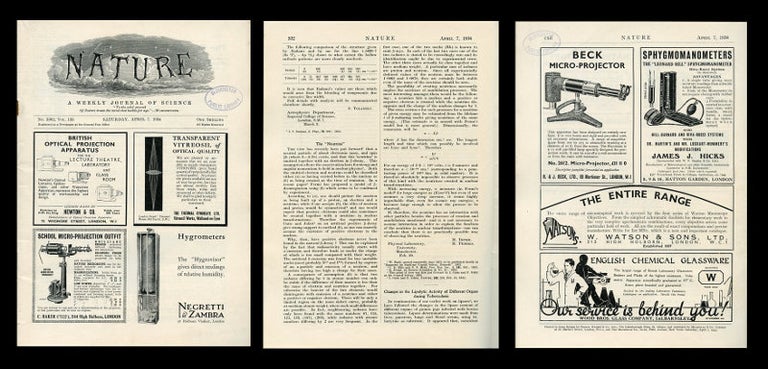The Neutrino in Nature 133, No. 3362, April 7, 1934, p.532
London: Macmillan, 1934. 1st Edition. FIRST EDITION IN ORIGINAL WRAPS of the first calculation of what is now called the 'neutrino cross section;' more specifically, Bethe and Peierl's paper presents the first calculation of a measure of the probability of a collision. Together, they used general principles to relate the chance of beta decay to the probability of a neutrino interacting with matter" (Close, Neutrino). Neutrinos, a product of several nuclear reactions (including nuclear fusion and radioactive decay) are elementary subatomic particles with no electric charge, very little mass and .5 unit of spin. The study of neutrino interaction physics played an important role in ascertaining the validity of the theories of weak interactions and electroweak interaction. All totaled, "the prediction, discovery and understanding of the neutrino would take scientists almost 100 years. It was clear from the start that discovering the neutrino would not be easy. Fermi proposed his theory of beta decay in 1934, "stating not just that a neutrino could pick up electric charge and reveal itself by bumping into matter, but [also] predicted under what circumstances it would do so, and with what likelihood. This was where the difficulties began. "By 1934 there were enough data on beta decays from a range of elements that Fermi's theory could tell the overall chance of neutrino, electron, neutron and proton interchanging identities at a single point. It turned out to be trifling. Hans Bethe and Rudolf Peierls, two of the leading young theoreticians, realised that with this information and Fermi's theory, they could deduce the probability of interaction between neutrinos and matter, whereby a neutrino in flight might be exposed. "Hopes that Fermi's insight would lead to the neutrino's discovery were short-lived. [In this paper] Bethe and Peierls found that the chance of neutrinos revealing themselves in this way were puny. Their calculation implied that a neutrino produced in beta decay could travel through the whole Earth without interruption: 'like a bullet through a bank of fog.'" "The interaction between a neutrino and matter became known as the weak force, once it was realised that a neutrino has a trifling chance of interacting with anything. Being electrically neutral, the neutrino does not respond to the electromagnetic forces that hold molecules together. Nor does it feel the strong forces that grip atomic nuclei. It only feels gravity and the weak force. The chance of a neutrino giving itself away by hitting a nucleus in some material was so small that the general opinion agreed with Bethe and Peierls' conclusion: 'There is no practically possible way of observing the neutrino' (Close, 2010). In fact, the odds of such an interaction were "small enough that the distance an average neutrino would travel through water between collisions would be on the order of 10 light years!" (History of Physics: The Wenner Collection). "Interestingly, this prediction for reactor neutrino cross sections is still accurate today, up to a factor of two required to account for the then unknown phenomenon of maximal parity violation in the weak interaction" (Soler, Neutrinos in Particle Physics, 65). Item #450
CONDITION & DETAILS: London: Macmillan & Co., Ltd. Volume 133, No. 3362. Original Wraps. (10 x 7 inches; 250 x 175mm). Original paper wraps. Ex-libris: bearing only a very faint stamp on the front wraps. Near fine condition in every way.
Price: $400.00

